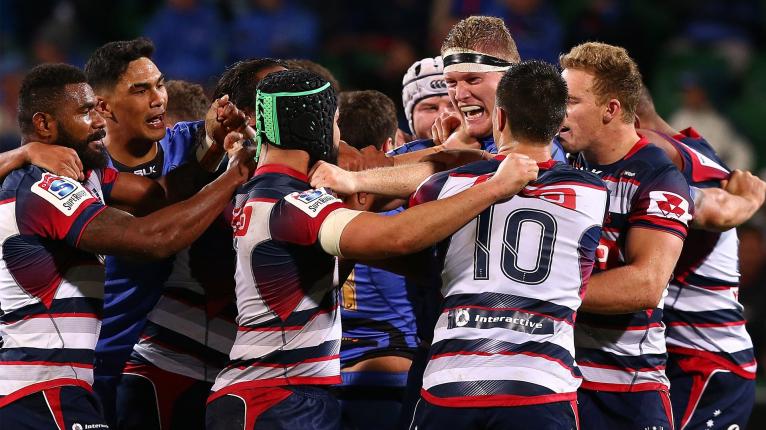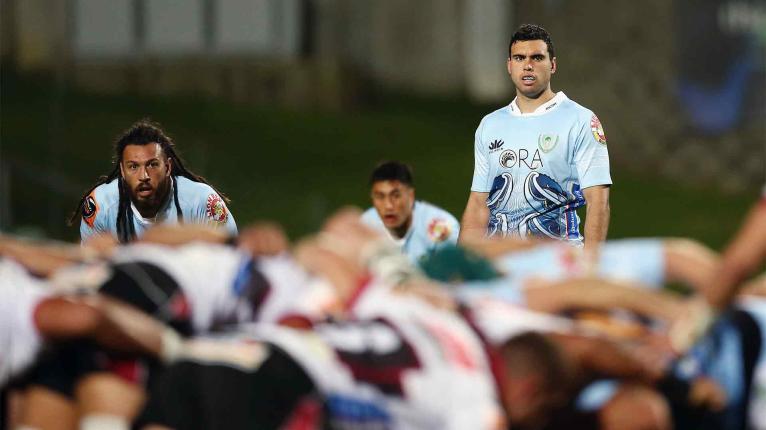There’s a natural assumption in New Zealand rugby that time will always prove to be the great healer.
Good players just need time to find their form again. Struggling teams just need time to find themselves. Competitions that don’t immediately grab the imagination, just need time to win everyone over.
Mostly, but not always, patience has paid off. In New Zealand, time has more often than not proven to be a valuable investment which has paid big rewards.
Dan Carter came good in 2015 when All Blacks coach Steve Hansen was brave enough to keep picking him. The Highlanders won the Super Rugby title that year after they had been stuck with Jamie Joseph as coach following the disastrous campaign of 2013 and really, the World Cup was a Kiwi invention, and it took an age for World Rugby to be convinced to even have one. Now look at it.
Waiting is New Zealand’s strong suit, which is why they have been prepared to keep believing that their friends across the Tasman Sea are going to get their act together and turn Super Rugby Pacific into the encapsulating, brilliant competition it used to be.

Somehow, New Zealand continues to keep the faith that Australia will find a way to drive up the quality of its five Super Rugby sides and inject Super Rugby Pacific with a greater level of drama, uncertainty and with it, higher fan appeal.
No club competition has plunged in popularity the way Super Rugby has in the last decade. From once being universally recognised as the best provincial entertainment in the world, it now barely registers in Australia, while even in New Zealand, TV audience figures are well down on historic highs and 10,000 is considered a good attendance when the old benchmark used to be 20,000.
Australia’s current broadcast deal best illustrates how little traction Super Rugby has. The previous deal RA struck with Foxtel for 2015-2021 was worth NZ$57m a year. The current one, with Channel Nine, is valued at $31m a year, a mere pittance in comparison with the figures paid to the AFL and NRL.
More important from a New Zealand perspective has been the inability of the competition to prepare the All Blacks for Test rugby.
This problem has been particularly acute since 2021 and the split with the South Africans. Super Rugby Pacific is missing a physical edge. There is not a strong enough focus on set-piece excellence, few teams have strong and persistent kicking strategies and while the breakdown is frantic, it doesn’t replicate the same intensity that the players encounter in Test rugby.
The strategy of just hoping Australia comes right is one that is being pursued with no evidence to support it.
There are too many easy moments for the Kiwi players when they take on the teams from across the Tasman and it was telling that last year All Blacks coach Ian Foster made reference to his team coming into the Irish series underprepared. He specifically put the blame for that on Super Rugby Pacific.
The strategy of just hoping Australia comes right is one that is being pursued with no evidence to support it.
For the better part of the last decade, Australia has been in a fight for credibility, desperate to prove it has the on-field and off-field resources to successfully run five teams.
Rugby Australia pushed to win a license for the Western Force to join Super 14 in 2006 and then pushed yet harder again to win inclusion for the Melbourne Rebels in 2011.
But expansion has broken Australia. They don’t have the money or the players to stretch themselves that far and the results speak volumes.

Australia had just one team in the playoffs between 2015 and 2019, and in 2016 none of their sides recorded a victory against New Zealand opposition.
When Covid saw New Zealand’s border shut for two years and effectively ended South Africa’s involvement in the competition, two things were learned.
The first was how important it was to have an alliance with Australia and other partners in the Pacific region as New Zealand couldn’t build a long-term viable competition on its own.
With no other choice, NZR had to launch Super Rugby Aotearoa in 2020 just to give the players something to do and while it was cracking entertainment, the players made it clear that it wasn’t a long-term viable proposal.
“The footy is awesome, the content is really good, and the games are always close,” said Hurricanes captain TJ Perenara. “It’s like Test match footy every time [but] I’m not sure it’s sustainable playing New Zealand teams back-to-back with only two byes.”
This is New Zealand’s lot now. They can’t ditch the Aussies or persuade them to drop a team or two – something NZR accepted last year when it agreed a deal to operate Super Rugby Pacific until at least 2030.
The second key lesson came when NZR tried to take control of Super Rugby and tell Australia it could apply to have a maximum of three teams involved.
The Aussies laughed that off and said they would be having five, or they would be off to do their own thing. NZR had no alternative but to agree, but made it clear to Rugby Australia that if they wanted five teams, they would have to pay for five teams.
Unlike previous years, there would be no sharing and splitting of broadcast revenue – although NZR has subsequently backed down and given $7m to RA.
And so here we are now, in the second year of Super Rugby Pacific proper and still there is no evidence at all that Australia can pull this off: that they can somehow make all five of their teams competitive.
But this is New Zealand’s lot now. They can’t ditch the Aussies or persuade them to drop a team or two – something NZR accepted last year when it agreed a deal to operate Super Rugby Pacific until at least 2030.

After which RA chief executive Andy Marinos said: “RA and NZR are committed to the development of the most exciting form of rugby in the world.”
Which was a bold statement indeed and one that may come back to haunt the former Welsh midfielder if things continue as they are.
If Super Rugby Pacific is going to succeed, NZR is going to have to proactively help its old foe.
Just waiting isn’t going to do anything and TV audiences and gate receipts are going to continue to decline unless there is some kind of active plan to help the Australians turn themselves around.
Several easy-to-implement initiatives surely now must be considered. The first is that NZR could change its eligibility policy to enable players contracted to Australian Super Rugby sides to play for the All Blacks.
There has to be consideration given to bringing more Australian players into New Zealand’s provincial teams.
It’s hardly a wild idea as the players will not be out of sight and out of mind and maybe it would suit a handful of senior All Blacks to play a couple of seasons in Melbourne or Sydney to freshen themselves mentally while having an overseas experience.
Seeing key Test players spend a season or two in Australia must be preferable to affording big-name All Blacks sabbatical clauses to play in Japan.
NZR could also consider creating a system where young Kiwis who are unlikely to play much for their New Zealand club can be loaned to Aussie teams.
And maybe most significantly, there has to be consideration given to bringing more Australian players into New Zealand’s provincial teams.
It would do wonders for emerging Australian talent to spend a couple of seasons being knocked about in the NPC.

What would also help, although it may in the short-term make life harder for the Australians, would be for NZR to ditch its workload management strategies which demand leading All Blacks to miss various games.
It does nothing for fans to see half-strength teams in action because the big names are an enforced break – saving themselves for the All Blacks. The commercial damage is intense and who can market a competition as authentic when no one can be sure when the star men will be involved?
The point is, something needs to change or Super Rugby Pacific is going to fail to keep the best players in New Zealand and Australia.
New Zealand can’t afford to play the waiting game.



People who keep on complaining about the rest days should research how often the top players are rested in Ireland. Seems to work ok for them.
This article says NZR gave RA 7Mil. Then it wants NZR to help Aus rugby. What did Aus do with that 7mil? Sign a 19yo rugby League player for 1.6 mil a year. I can see many valid reasons for NZR helping Aus but I see no decent reason for NZR to have no control over where that help goes. RA has a history of waste and will waste NZs donation as well.
I agree with Spew81. Maybe a loan system of some sort, but certainly guarantee that no NZ player will ever be a Wallaby.
Only let NZ contracted players play in Australian teams if Rugby Australia signs a legally binding agreement that they can’t be picked as Wallabies e.g. if they play there so long they meet residency qualification; if those players choose to make themselves available for the Wallabies the residency clock starts at zero. Otherwise the NZRU would just be shipping talent to Australia.
Nothing wrong with letting some Australian teams in the NPC, as long as Rugby Australia pays for the trans-Tasman flights and accommodation, for all travelling teams.
NZR needs to show courage and jettison Aust if it wont cut its teams to 3.
A NZ only comp with overseas players and coaches would be more beneficial to NZ [AB's and public] than the club standard being offered by 4 of the 5 Aust teams.
But, in case you dont know the solution.... ask Eddie or "The Hammer".
Sorry should have added Foster is right never thought I would say it. Whilst Australia and Super Rugby is weak it doesn’t help the All Blacks in the modern professional world.
Totally agree.
Make Super Rugby like the NFL and allow any players to be brought and sold amongst the Franchises whilst all being eligible to play for their country regardless of where they play inside the Super Rugby including the new Island teams.
Sell the Franchises rather than the governing bodies.
Top 4 only finals.
Totally agree with Australian players trying to get in the NPC but maybe add OZ teams into program
Never understood my a national coach needs to teach skills which is what has happen to the last 5 Australian coaches